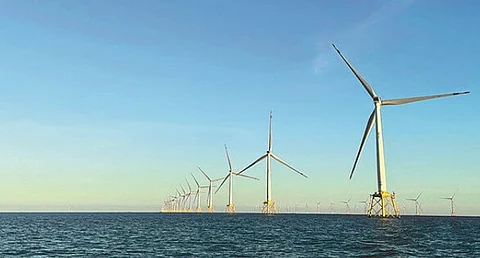

Clarksons Research has released a new briefing profiling China's offshore wind sector, including capacity forecasts, intelligence on vessel deployment and new province level analysis as part of an expansion of Chinese market content on RIN.
"China has rapidly grown into a major offshore wind market in last decade, overtaking the UK in 2021 as the world's largest producer of electricity from offshore wind," Steve Gordon, Managing Director of Clarksons Research, commented. "Our projections suggest that by the middle of the decade, Chinese offshore wind capacity will more than double to 54 GW and involve 177 farms and 8,700 turbines by end 2025."
Gordon added that installed offshore wind capacity off China is set to grow by 12 per cent in H2 2022, a moderating of growth after the record start-ups of last year and ending of central government subsidy.
Growth underpinned by developments in Guangdong and Jiangsu
"Capacity expansion in China looks set to be underpinned by Guangdong province (planned to reach 17 GW by end-2025 (up 209 per cent from today's 5.5 GW)) and Jiangsu province (projected to reach 15 GW by end-2025 (up 27 per cent from 11.8 GW)).
"The 14th five year plan remains supportive (i) directly to offshore wind including some continued moderate province level subsidy and further policy support towards identified clusters and deep sea/floating wind projects and (ii) broader government targets on peak CO2 emissions (2030), net zero (2060) and overall renewables targets (>1,200 GW by 2030).
Gordon said major Chinese offshore wind developers include CTG (3.4 GW of installed capacity, 4.3 GW under development, 2.6 GW planned), SPIC and CHN Energy with the greatest expansion by 2025 set to be by CTG. On a global basis, Chinese developers constitute six of the top 10 by active capacity although all their capacity is exclusively within China.
Turbine manufacturers dominate domestic market
Chinese turbine manufacturers (OEMs) continue to dominate in the domestic offshore wind market, accounting for just under 99 per cent of active offshore wind capacity off the country. Leading Chinese OEMs include Shanghai Electric WP (8.3 GW of installed capacity, 1.2 GW under development, 900 MW planned). OEMs are facing some challenges during the "post-subsidy" period, as developers push to lower project costs and raw material prices (such as steel) rise significantly.
Chinese OEMs are expanding production capacities and breaking into overseas markets, such as Italy, Japan and Vietnam (with >350 turbines installed / under construction / potential).
"Investment in China's offshore wind supply chain has strengthened recently, with many offshore wind industrial supply chain clusters currently under construction or expansion in most coastal provinces," added Gordon. "These manufacturing facilities can supply equipment and components for offshore windfarms, including blades, generators, towers, foundations, and cables. Notably, the Dongying Industry Park and associated port is undergoing an expansion towards multi-GW turbine manufacturing capacity, as well as having two dedicated wind berths at port."
A total of 28 active WTIVs in domestic market
China remains the largest WTIV market globally, accounting for 28 units and 62 per cent of current WTIV deployment (albeit only 37% of deployment ≥ 1500t crane size). Demand for installation units looks set to remain strong over the coming years despite the current "post-subsidy" period, with 10.5 GW of new capacity having recently reached FID or entered construction. Owners of WTIVs in Chinese waters include Nantong Ocean Water (four vessels), Shanghai Ouyang (four vessels) and CCCC Third Harbour (four vessels).
"While the average turbine capacity in China has historically been lower compared to that of European markets (2021: average turbine size in China was 5.9 MW versus 7.8 MW in Europe)," said Gordon, "our projections suggest that by end-2025 the average turbine capacity of start-ups will grow to >8 MW, prompting Chinese WTIV owners to follow in the wider WTIV upsizing trend (Chinese owners account for 59 per cent of ≥1500t WTIVs on order)."
The size of the specialist fleet supporting offshore renewable activity in China continues to expand. The domestically Chinese owned fleet has increased year-on-year over the past decade with some vessel sectors including WTIVs, CTVs and crane vessels having expanded significantly since start-2021, in order to meet the rapidly growing demand for vessels to support wind farm construction, as well as the increasing operations and maintenance work in China.
Offshore wind set to play vital role in energy transition
"The global offshore wind industry looks set to continue its exciting growth phase" remarked Gordon, "and our long-term scenarios suggest offshore wind will play a vital role in the energy transition, potentially providing between seven per cent and nine per cent of global energy supply by 2050 (offshore wind produces just 0.3 per cent today). Globally our projections suggest 248 GW and 30,000 active turbines by 2030 (today there is 53.1 GW and 11,000 turbines)."
The briefing has been released onto Clarksons' Renewables Intelligence Network (RIN) platform.
